Thin Ice: Year-Long Monitoring in Missouri Reservoirs
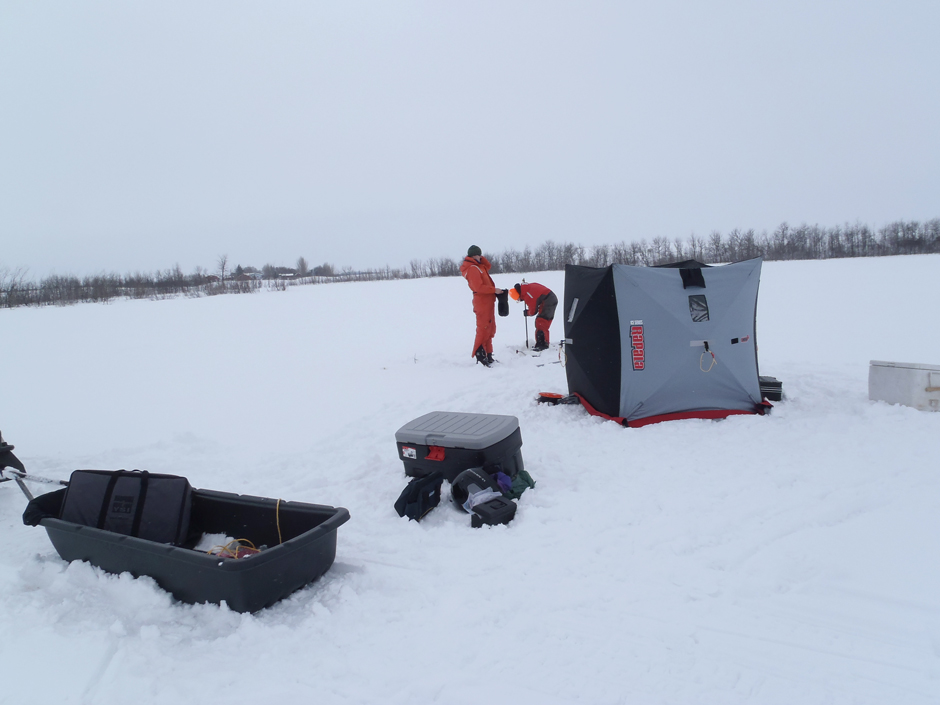 Global Institute for Water Security, University of Saskatchewan staff- Sheena McInnes and Heather Wilson- conduct winter limnology on a Saskatchewan reservoir, Canada at -30 degrees Celsius. (Credit: Rebecca North / MU Limnology Lab, University of Missouri-Columbia)
Global Institute for Water Security, University of Saskatchewan staff- Sheena McInnes and Heather Wilson- conduct winter limnology on a Saskatchewan reservoir, Canada at -30 degrees Celsius. (Credit: Rebecca North / MU Limnology Lab, University of Missouri-Columbia)The value of multi-lake studies is well understood by international organizations like the Global Lake Ecological Observatory Network (GLEON) and the scientists who work tirelessly to provide data to the larger network. Rebecca North, an associate professor at the University of Missouri-Columbia, is one of many researchers involved in multi-lake research initiatives and conducting research locally in her home state.
Having been born and raised on the shore of Lake Ontario, North grew up in a community that revolved around water. She also saw firsthand one of the worst water quality bodies of the world, the Bay of Quinte, decline throughout her lifetime. As a result, North has dedicated her career to studying why lakes turn green and working with communities to develop strategies that protect water resources.
Bringing Researchers Together Over Data Needs
For North, the value of her work is how the data she collects helps the community. Recreation, drinking water and other services all rely on the health of water bodies. “I think water quality is important to everyone, and we want to maintain it,” states North.
Locally, the University of Missouri has conducted the Statewide Lake Assessment Program for 40 years. While the program has been mostly supported through discrete sampling efforts, adding the buoys opens the door for more continuous real-time data.
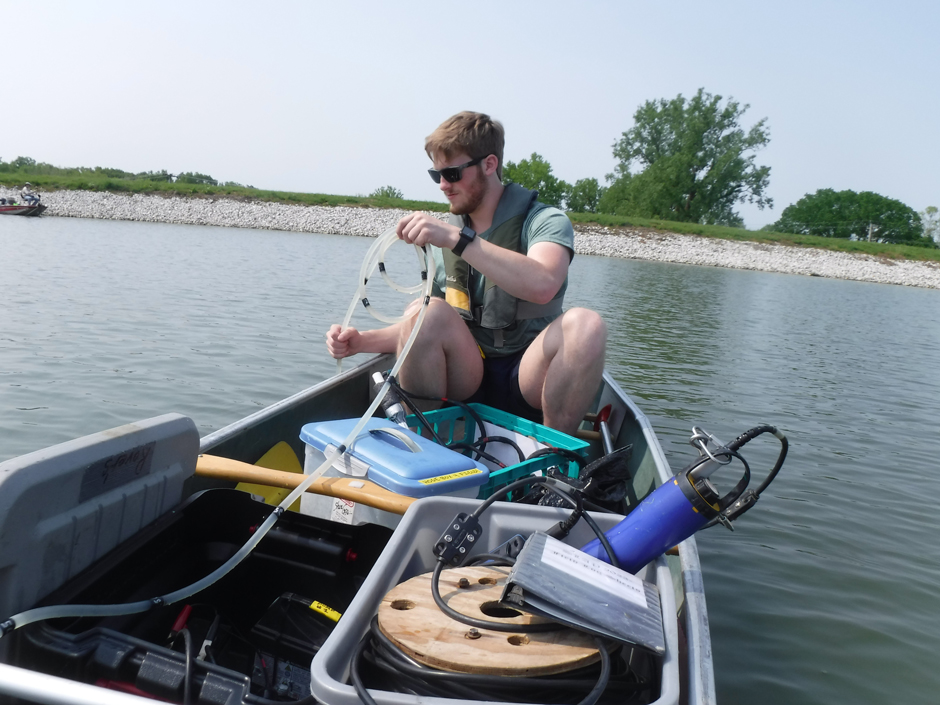
School of Natural Resources undergraduate student- Jacob Skipton- collects water samples from a Missouri reservoir. (Credit: Chris Kalogeris / MU Limnology Lab, University of Missouri-Columbia)
As a member of GLEON, North was excited to order her first pair of buoys last year. GLEON started off with lake buoys, and North has been looking forward to finally joining the club.
“This will be my first buoy! I’m putting two out on Missouri reservoirs this summer. And to my knowledge, those are the first two research reservoirs in the state—and there’s not that many even in the Midwest,” explains North. “I’m the chair of GLEON’s Committee for inClusive Collaboration (CCC), and so it’s nice to finally embrace the whole thing by having my own set of buoys to participate,” she continues.
One of the major benefits of being part of an organization like GLEON is the data-sharing component and the ability to connect scientists across the country based on shared research goals. Many multi-lake studies have been born from GLEON’s collaborative approach to lake monitoring. Even independent research can be used to support future research efforts, making consistent, year-round data essential.
Scientific Collaboration and Changing Winter Dynamics
In addition to her CCC work with GLEON, North is one of several researchers collaborating on the Thin Ice Project, serving as the reference point for lakes that don’t freeze. The Thin Ice Project differs from typical multi-lake studies as the researchers plan to leave their monitoring equipment in throughout the year, including the winter months, in order to capture all of the seasonal dynamics of their lakes.
According to North, the National Science Foundation-sponsored project will focus on year-round processes and linking climate change and changes in ice cover to changes in phytoplankton populations and harmful algal blooms. What separates this project from previous multi-lake studies is the inclusion of light attenuation monitoring in addition to general water quality data.
North explains, “We have light sensors at three different depths in all our model lakes, which I think will be unique.” She continues, “We’ll get the attenuation coefficient year-round, and see what happens when we get ice cover, and then it melts again, and then it refreezes—it’s really hard to get that kind of data because it’s hard to logistically get out [to sampling sites] when things are that uncertain.”
The two Missouri reservoirs included in the study are the Marceline Reservoir and Table Rock Reservoir. Because the two selected reservoirs are relevant to their respective bordering communities as water resources, the research is also supported by an EPA Star Grant, Valuing Heartland Reservoirs, an economics-facing grant focusing on the socioeconomic impacts of water quality in specifically Midwest reservoirs.
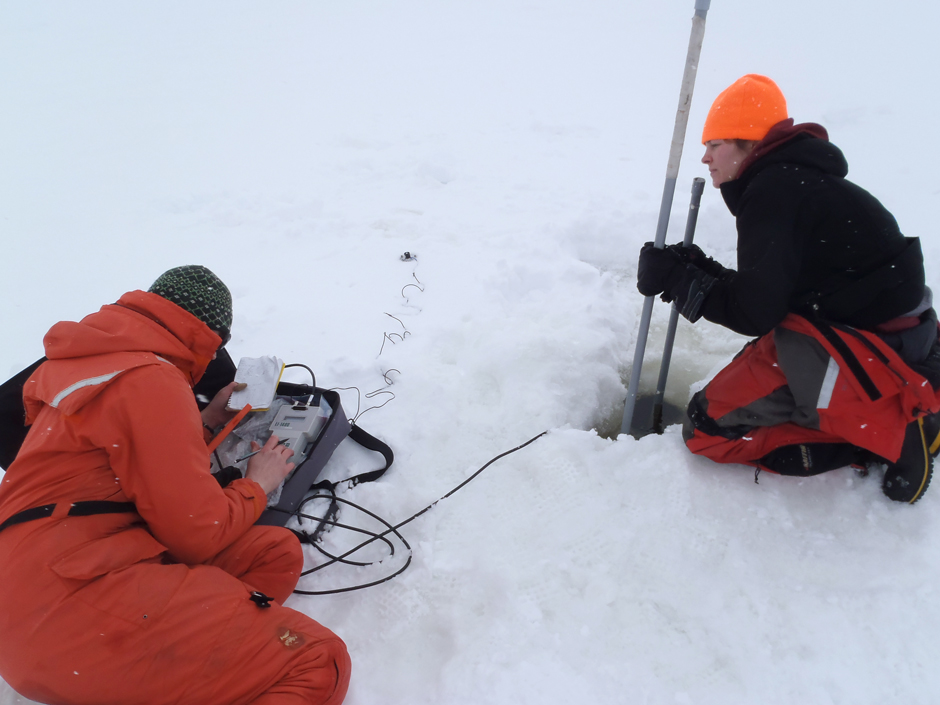
Global Institute for Water Security staff- Sheena McInnes and Heather Wilson- take under-ice profiles on a Saskatchewan reservoir, Canada. (Credit: Rebecca North / MU Limnology Lab, University of Missouri-Columbia)
In addition to the data contributions to the Thin Ice Project, the data will be used to develop models that allow lake behaviors to be predicted under various scenarios. The models will then be used to shape policies, programs, and initiatives to protect water resources. Finally, the public will be surveyed about various solutions and approaches to decide what is achievable for the region.
The buoys will support both projects and provide valuable data to local agencies that rely on monitoring data for source water treatment and recreation.
The Missouri reservoirs are a unique data point for the Thin Ice Project, serving as somewhat of an end-stage for lakes if temperatures continue to rise. Ice cover on the two reservoirs is hit or miss and is subject to thawing and refreezing throughout the season. Compared to other lakes in the study that spend a large amount of the winter season covered in ice, the Missouri reservoirs represent a possible dataset in a pessimistic future for ice-covered lakes.
Reservoirs are also chemically and physically quite different from natural lakes, so the water bodies offer a unique perspective on winter dynamics. Even from a logistical approach, the varying water levels of reservoirs can make the deployment of a data buoy difficult.
In particular, North and the other researchers included in the study have had to work around various deployment complications as winter monitoring comes with its own risks. Equipment can be destroyed or damaged by ice conditions and cold temperatures, so each system must be designed to meet the needs of each lake while gathering uniform data.
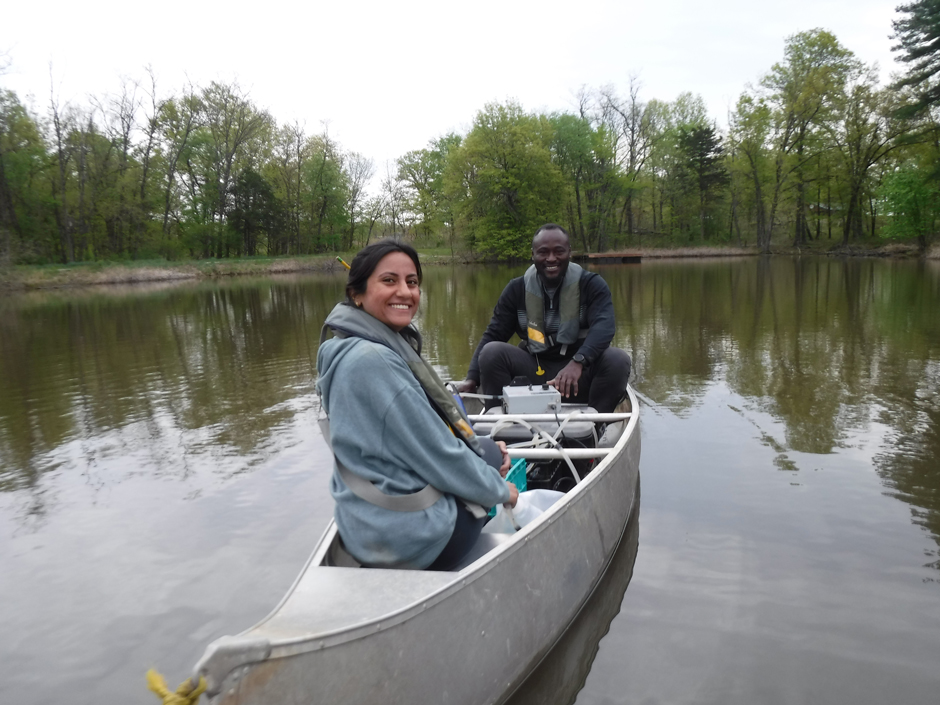
Water Resources graduate students- Fatima Laraib and Yusuf Olaleye- conduct a thiamine addition experiment on Crow Pond, Prairie Fork Conservation Area, Missouri. (Credit: Rebecca North / MU Limnology Lab, University of Missouri-Columbia)
Monitoring Systems in Missouri Reservoirs
For both the Marceline and Table Rock Reservoirs, a CB-450 data buoy will be deployed year-round in order to capture fluctuations in water quality throughout the year. Attached to each of the buoys are a LI-COR 190R and 192 PAR, an Airmar 200WX-IPX7, and a NexSens data logger, which is connected to multiple YSI EXO3 sondes that have sensors measuring temperature, oxygen, chlorophyll a (a proxy for phytoplankton biomass), phycocyanin (a proxy for cyanobacterial biomass), conductivity, and pH.
The NexSens data logger records data from the sensors and weather station, which is then available to the research team online through the WQData LIVE portal. For the Marceline Reservoir, the University of Missouri’s Water Center has agreed to host the website so the public can access the data in real time.
The Table Rock Reservoir is on the border of Arkansas and is managed by the U.S. Army Corps of Engineers, who have their own monitoring initiatives and will compare the data for accuracy before releasing information to the public.
Both reservoirs’ data will be compiled in the Thin Ice Project’s multi-lake data set and used to develop models to test and shape future resource management. The buoys help take some of the burden off of sampling teams who may not always be able to reach a site for sampling, collecting and transferring data to the cloud without needing to visit the site. Ultimately, the Thin Ice Project will provide a year-round baseline for lake dynamics, which will help managers, scientists, and the public better understand lakes.
“[Managers] will be watching the buoy data to see if they need to change the way they treat the water. They do have historical harmful algal blooms in that reservoir and have had high toxin concentrations in the past [. . .] It’s nice to be able to give them a tool that they can use to help to improve the drinking water treatment,” explains North.
North is also planning on deploying a sunken buoy on Bethel Lake as part of the Reservoir Observer Student Scientists (ROSS) program. Students will gather samples for assessment while the buoy collects PAR, temperature, and dissolved oxygen data.
Instead of using a telemetric system for real-time data on the lake, a PME miniDOT and miniPAR will be deployed. Both instruments store data internally, which can be downloaded and investigated to create estimates on the productivity and metabolism of the lake.
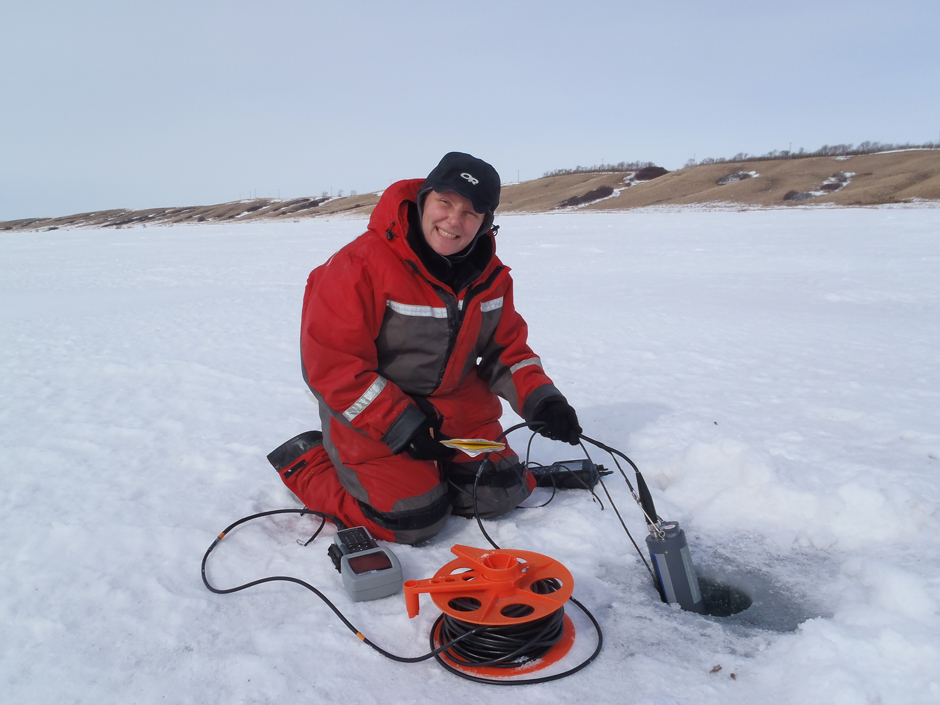
Rebecca North takes a YSI sonde profile through the ice on Lake Diefenbaker, Saskatchewan, Canada. (Credit: Sheena McInnes / Global Institute for Water Security, University of Saskatchewan)
Conclusion
Ultimately, all these monitoring efforts share the same goal of monitoring lakes throughout the year, including the traditional off-season for environmental monitoring. Winter data is often lacking in studies due to the challenges that are introduced, but North argues that winter monitoring is essential.
She explains, “[Winter dynamics] are literally changing around us, and we don’t have any baseline data from which to make projections about what to expect in the future. So that’s kind of the premise behind the Thin Ice Project [. . .] We’re using a latitudinal gradient of lakes to try to predict what’s going to happen in the future when we completely lose our ice cover because, unfortunately, that is the trajectory we’re currently on.”
She continues, “Some year-round data from Bethel Lake show that the highest microcystin and cylindrospermopsin concentrations are in the non-summer seasons. So, there is some suggestion that we should be paying more attention to year-round data because we know that winters and what we expect out of winter is changing rapidly.”
*This is part two of a two-part story on the Thin Ice Project. To read part one, click here


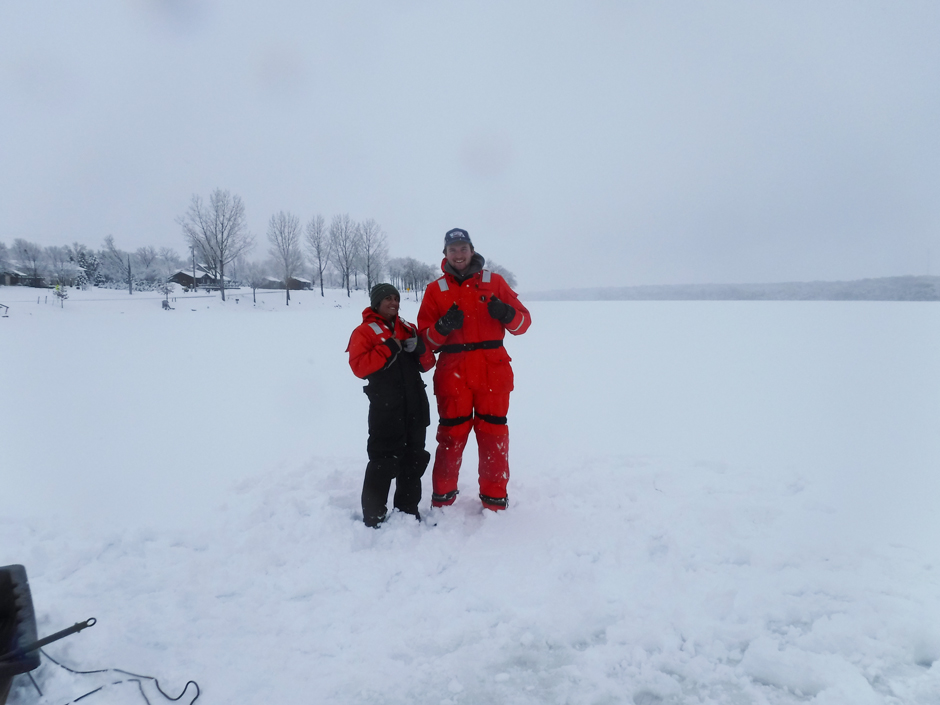


0 comments